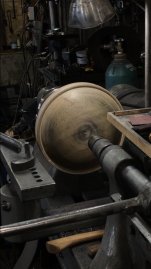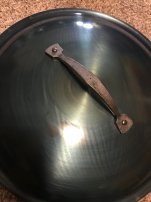Skillet Maker
Plastic
- Joined
- Dec 1, 2022
Hi! I'm new here, my name is Peter
I need some help figuring out how to use Phenolic as a spin form for metal spinning.
I have searched far and wide and solid info on what grades of phenolic to use and machining it has been very elusive.
Here's the problem:
I spin the lid for one of my big pans on Eastern Hard Maple. The wood grain from the Maple telegraphs though the spun part. When I hand sand the lid surface (while spinning on the lathe) the grain pattern magically appears, I don't like that. Also, I've had to make little repairs around the perimeter of the form, first with Bondo and then with Maple wedges glued into a "V" cut that removed the damaged area. The V's are only about 3/8" wide. As I used the form with the new wood wedges, I found that the wood around the wedges has been compressed from repeated spinning over time and the new wood, being less dense has been compressed below the plain of the surrounding wood. This leaves a little ripple on the lid at that spot. The lid is a large dome shape so making a replacement form in steel is both time and cost prohibitive. I've tried with smaller lids.
On youtube I have seen video's of people using phenolic as a spin form. Do any of you wise people here have any experience doing this? I think I'll be turning the Phenolic form on a wood lathe, thats the plan anyway. I'll also need to cut threads (8tpi X 1") in it for mounting on the lathe.
I'm interested in learning what grades are best for the application I'm proposing and insight into machining it. From what I have found so far the paper based mechanical or economy grade it the one to use. I have piece of canvas economy grade I'm goin to play with for one of my smaller lids. The piece I'll need for the big lid replacement is 2.5" thick X 13.5" square. I want to be sure I'm getting the right/best stuff because it ain't gona be cheep!
Sorry for such a long winded first post but this problem has been dogging me for a couple a years...
Thank you fro any and all suggestions!
Peter
I need some help figuring out how to use Phenolic as a spin form for metal spinning.
I have searched far and wide and solid info on what grades of phenolic to use and machining it has been very elusive.
Here's the problem:
I spin the lid for one of my big pans on Eastern Hard Maple. The wood grain from the Maple telegraphs though the spun part. When I hand sand the lid surface (while spinning on the lathe) the grain pattern magically appears, I don't like that. Also, I've had to make little repairs around the perimeter of the form, first with Bondo and then with Maple wedges glued into a "V" cut that removed the damaged area. The V's are only about 3/8" wide. As I used the form with the new wood wedges, I found that the wood around the wedges has been compressed from repeated spinning over time and the new wood, being less dense has been compressed below the plain of the surrounding wood. This leaves a little ripple on the lid at that spot. The lid is a large dome shape so making a replacement form in steel is both time and cost prohibitive. I've tried with smaller lids.
On youtube I have seen video's of people using phenolic as a spin form. Do any of you wise people here have any experience doing this? I think I'll be turning the Phenolic form on a wood lathe, thats the plan anyway. I'll also need to cut threads (8tpi X 1") in it for mounting on the lathe.
I'm interested in learning what grades are best for the application I'm proposing and insight into machining it. From what I have found so far the paper based mechanical or economy grade it the one to use. I have piece of canvas economy grade I'm goin to play with for one of my smaller lids. The piece I'll need for the big lid replacement is 2.5" thick X 13.5" square. I want to be sure I'm getting the right/best stuff because it ain't gona be cheep!
Sorry for such a long winded first post but this problem has been dogging me for a couple a years...
Thank you fro any and all suggestions!
Peter



